Chris Landreth is a unique director with a unique style. His previous short films Ryan, Bingo and The End showcased complex characters using an almost surreal approach to computer animation. Landreth talks to fxguide about his latest animated short, The Spine, which focuses on the tumultuous lives of married couple Dan and Mary.
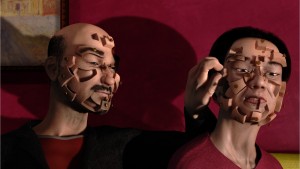 fxg: What makes you want to tell the stories you tell using the medium of computer graphics?
fxg: What makes you want to tell the stories you tell using the medium of computer graphics?
Landreth: One thing is that I don’t see this being done by many, if any, other people. Using animation to tell emotional or psychological-based stories of people who are otherwise real who are among us – I consider Dan and Mary to be very real people. Animation is generally used for fantasy or sci-fi, adventure or cartoony stuff. I’ve always thought there was another way that you could use it. That’s why I’m drawn to it.
fxg: This seems like a very personal story. How did the idea come about?
Landreth: It came from having seen couples, people who have been in relationships for years or decades and my kind of wondering why these people are together when the nature of the relationship seems so destructive and poisonous. Often when I’ve come to the answer I’ve realised that it’s not just stupidity or habit that keeps people together. It’s often a very psychologically dramatic back-story that keeps these relationships going and keeps people’s identities from growing and keeps them, at least on the surface, from being very stunted.
fxg: How long was the story in your head, in terms of development?
Landreth: It took a full year, I would say. I wrote the first draft of the script pretty quickly over a few days in January 2007. In spite of that having gone very quickly, the following year was spent getting the story into a state that I would be able to animate. And also to get the production going. So it was a year of development.
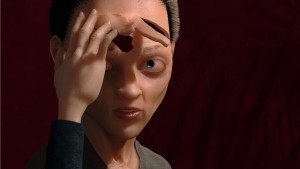 fxg: What sort of design and concept work was involved?
fxg: What sort of design and concept work was involved?
Landreth: We did concept sketches – I was doing most of them – over the Spring period following the early part of 2007 for about four months. I was working with a couple of modelers and a storyboard artist who I’d worked with on Ryan. It was May by the time we had a really good storyboard that I could put into an animatic and actually start adding dialogue to and temp sounds and music. A few months after that it was a matter of getting a production structure in place with the National Film Board of Canada and with the studio, C.O.R.E. Digital Pictures. We also got the involvement of Seneca College, which was a big involvement.
fxg: What drove you to involve C.O.R.E. and Seneca students?
Landreth: When we put together a pipeline for the film, we went through about seven different iterations of the schedule that would get this done in a year. With the budget that we had, which wasn’t great by any means, we realised that in order to do the animation part of it we would need to have students because they’re free, basically. Fortunately, at that time, some people at Seneca, particularly a guy called Mark Jones who runs the animation programme there, had got in touch with me about getting some students involved. We decided that we’d have 15 students involved, eight on animation and the rest doing other parts of the production.
On Ryan, we had Seneca involved, but on The Spine they were far more involved. We had four animators on Ryan and a lot of other professionals working on other parts. The student contribution on The Spine was a much bigger proportion. All of the animation was done by students and things like texturing and lighting also at the studio C.O.R.E. but by students from Seneca.
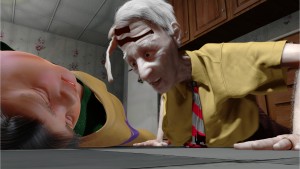 fxg: Could you go into some of the technical details of the film?
fxg: Could you go into some of the technical details of the film?
Landreth: We were using the latest version of Maya, Maya 2008. We had used Maya version 4 on Ryan. There were a lot of new things we could do, particularly in effects and rendering. In The Spine, we used a lot of nCloth which they introduced in version 8.5. We really used that a lot, not just for clothing but for pretty much all of the soft body and rigid body dynamics.
The other thing was the rendering aspect. We were able to use sub-surface scattering for skin and global illumination, ambient occlusion – great stuff like that. We rendered most of the film in Houdini. It’s a great alternative animation package but one of the things they do really well is rendering. The render’s called Mantra. We did about 80% in Houdini and the other 20% in mental ray in Maya with all those bells and whistles I mentioned before.
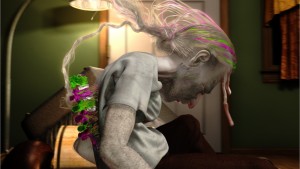 fxg: The actual spine shot is a standout – can you break it down?
fxg: The actual spine shot is a standout – can you break it down?
Landreth: The is the shot as the spine grows up Dan’s back as the camera’s corkscrewing around him. That really was our big money-shot in the film. We call them OSS’s or ‘Oh shit shots’. That was one of the shots done in mental ray. For that the shot the pipeline went all the way through Maya.
It was one of the first shots that I worked on in the very beginning doing layout. You just put stiff characters in there and have a very crude version of the surroundings – the room in this case. But what’s not crude in layout is the camera. So you try very hard in layout to get the camera to do exactly what’s going to end up in the film. That usually doesn’t change, but if it does change it’s a formal process of going back into the pipeline and changing it. So the camera move was something we tried to get right from the very beginning. We passed it off to the animators and that particular shot took about three weeks to do. The person who worked on that, Dianna Basso, a student at Seneca, did a great job of getting Dan’s expressions and motions and body gestures to work.
Then it came to effects. In the case of Dan, a lot of the appearance of his body is not something an animator can animate because he has a melting body. I did the effects on that particular shot. We used nCloth to do not only the cloth on his shirt and pants but also his actual body. His body at the beginning of the shot is this crumpled melted mass when he’s sitting down and when the shot progresses his skin becomes more like that of a human – or the appearance of one. It kind of unruffles and becomes a regular human body. Then we did the clothing in nCloth.
For the spine itself, we used nCloth to make the individual vertebrate pop into place. They unravel from a crumpled piece of paper and inflate and spring into shape. The hair was done with Maya’s hair dynamics. We used a lot of trickery to make three strands of hair spontaneously form into a braid. As the spine’s going up his back, the braid is going down. Then a lot of attention of rendering and lighting and ‘Voila’!.
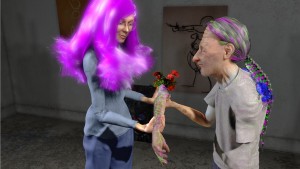 fxg: I love the technical details, but I think the stand out thing is the story and the style of storytelling. Where do you think you might be headed with that style?
fxg: I love the technical details, but I think the stand out thing is the story and the style of storytelling. Where do you think you might be headed with that style?
Landreth: I’ve used this style in Ryan and The Spine, having explored it in some earlier films, Bingo and The End. I would say that if you use this technique sparingly – I mean, don’t try and go too over the top with it – I think that it’s possible to bring out a new layer of storytelling to get the idea of these things not being literal but representing something more psychologically or emotionally based – then I think you’ve got a way of telling a story without having to use expository dialogue and stuff like that. If you can get people into that universe I think there’s so many possibilities for using it as a visual storytelling technique.
Images and clip © 2009 National Film Board of Canada
